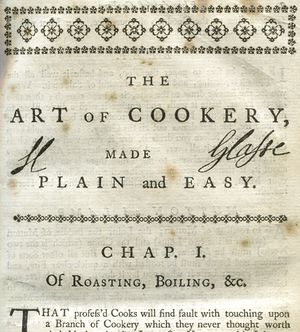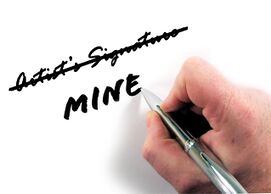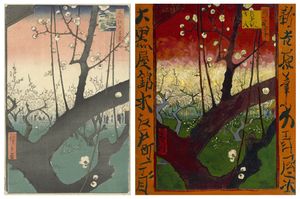السطو الفكري
السطو الفكري أو الانتحال عملية تقديم أعمال أدبية أو فنية أوموسيقية لشخص آخر كأنها أعمال للشخص المنتحِل. فالطالب الذي ينسخ من المراجع مثلاً يقع في الانتحال. ولايحتاج العمل أن يكون مطابقًا للعمل الأصلي حتى يكون انتحالاً. ولكن يجب أن يكون مشابهًا بحيث يكون واضحًا بأنه منسوخ.
ويعد الانتحال عملاً غير أخلاقي. وتجعل قوانين حقوق الطبع (حق المؤلف) لكثير من الدول الانتحال والنسخ غير القانوني جريمة يعاقب عليها بالغرامة أو السجن، بالإضافة إلى أن صاحب حقوق الطبع، يمكن أن يرفع دعوى على أي شخص يقوم بالانتحال. وتمنع المعاهد العلمية الانتحال، والطالب الذي يقوم بالانتحال يكون عرضة للعقوبات التأديبية. والانتحال لايتضمن تبني أنماط شخصية وحبكة عامة أو أفكار أخرى من الأعمال الحالية. وكل الكتاب والفنانين تقريبًا، يقومون بمثل هذه الاستعارات ولكنهم يعبرون عن الأفكار بطرق جديدة. وقد اقتبس الكاتب المسرحي البريطاني الكبير وليم شكسبير الكثير من حبكاته في الأعمال الأدبية والتاريخية المنشورة، ولكنه حوّل المواد المستعارة إلى أعمال تعتبر له وحده.كما أن الانتحال لايتضمن عادة النسخ المسموح به تحت مبدأ الاستخدام المعتدل من قانون حقوق الطبع. ويسمح هذا المبدأ بنسخ محدود لأعمال شخص آخر بدون طلب السماح لأغراض كالتعليم، والأبحاث، ونقل الأخبار أو النقد. وفي أغلب الأحيان يجب ذكر اسم المصدر الأصلى للعمل.
. . . . . . . . . . . . . . . . . . . . . . . . . . . . . . . . . . . . . . . . . . . . . . . . . . . . . . . . . . . . . . . . . . . . . . . . . . . . . . . . . . . . . . . . . . . . . . . . . . . . . . . . . . . . . . . . . . . . . . . . . . . . . . . . . . . . . . . . . . . . . . . . . . . . . . . . . . . . . . . . . . . . . . . .
جوانب قانونية

في الجامعات والصحافة
في الفنون
تاريخ الفنون
طوال تاريخ الأدب والفنون in general, works of art are for a large part repetitions of the tradition; to the entire history of artistic creativity belong plagiarism, literary theft, appropriation, incorporation, retelling, rewriting, recapitulation, revision, reprise, thematic variation, ironic retake, parody, imitation, stylistic theft, pastiches, collages, and deliberate assemblages.[1][2][3][4][5][6]
في سياقات أخرى
على الإنترنت
Free online tools are becoming available to help identify plagiarism,[7][8] and there are a range of approaches that attempt to limit online copying, such as disabling right clicking and placing warning banners regarding copyrights on web pages. Instances of plagiarism that involve copyright violation may be addressed by the rightful content owners sending a DMCA removal notice to the offending site-owner, or to the ISP that is hosting the offending site. The term "content scraping" has arisen to describe the copying and pasting of information from websites[9] and blogs.[10]
انتحال عكسي
Reverse plagiarism, or attribution without copying,[11] refers to falsely giving authorship credit over a work to a person who did not author it, or falsely claiming a source supports an assertion that the source does not make.[12][13] While both the term and activity are relatively rare, incidents of reverse plagiarism do occur typically in similar contexts as traditional plagiarism.[14]
انظر ايضا
- Academic dishonesty
- Appropriation (art)
- Article spinning
- Contract cheating
- Copyright
- Counterfeit
- Credit (creative arts)
- Cryptomnesia
- Détournement
- Document theft
- Essay mill
- Fair use
- Ghostwriter
- Joke thievery
- Journalism scandals (plagiarism, fabrication, omission)
- Multiple publication
- Musical plagiarism
- Parody
- Peer review § Plagiarism
- Plagiarism detection
- Plagiarism from Wikipedia
- Rogeting
- Scientific misconduct
- Source criticism
- Swipe (comics)
- An Uncommon Story, literary memoir by Ivan Goncharov
- The Anxiety of Influence, a 1973 book by Harold Bloom
- حق المؤلف
مصادر
الهامش
- ^ Derrida [1959] quotation: (p.40):[استشهاد ناقص] "The boundaries between permissible and impermissible, imitation, stylistic plagiarism, copy, replica and forgery remain nebulous."
- ^ Eco (1990) p. 95 quotation:
Each of the types of repetition that we have examined is not limited to the mass media but belongs by right to the entire history of artistic creativity; plagiarism, quotation, parody, the ironic retake are typical of the entire artistic-literary tradition.
Much art has been and is repetitive. The concept of absolute originality is a contemporary one, born with Romanticism; classical art was in vast measure serial, and the "modern" avant-garde (at the beginning of this century) challenged the Romantic idea of "creation from nothingness," with its techniques of collage, mustachios on the Mona Lisa, art about art, and so on. - ^ خطأ استشهاد: وسم
<ref>غير صحيح؛ لا نص تم توفيره للمراجع المسماةLands99 - ^ Alfrey (2000)
- ^ Genette [1982] note 3 to ch. 7, p. 433. quotation:
"transposition"... all the other possible terms (rewriting, rehandling, remake, revision, refection, recasting, etc.)
- ^ خطأ استشهاد: وسم
<ref>غير صحيح؛ لا نص تم توفيره للمراجع المسماةSteiner98pp437-459 - ^ "Apple accused of copyright wrongs" CNET
- ^ "Copyscape Searches For Scraped Content". WebProNews. Archived from the original on 2007-02-21.
- ^ Jones, Del (August 1, 2006). "Authorship gets lost on Web". USA Today.
- ^ Welch, Maura (May 8, 2006). "Online plagiarism strikes blog world". The Boston Globe.
- ^ ‘Plagiarism, Norms, and the Limits of Theft Law: Some Observations on the Use of Criminal Sanctions in Enforcing Intellectual Property Rights’ (2002-3) 54 Hastings Law Journal 167, 180.
- ^ "Academic dishonesty and misconduct: Curbing plagiarism in the Muslim world by Abdul Rashid Moten" (PDF). Retrieved 31 January 2019.
- ^ "The Intersection of Copyright Plagiarism and the Monitoring of Student Work by Educational Institutions by Mary Wyburn and John Macphail" (PDF). anzela.edu.au. Retrieved 31 January 2019.
- ^ "Reverse Plagiarism? Or, Did I Say That?". 2007-11-26.

